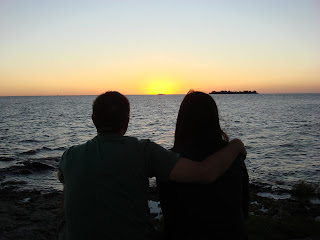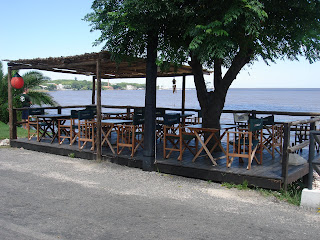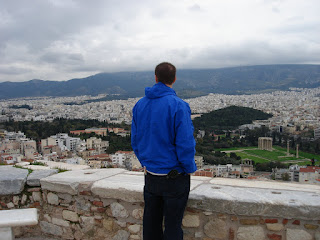Saturday, February 27, 2010
All Clear from Argentina
Hola from Buenos Aires. After the big earthquake in central Chile early this morning, we have received some worried emails, texts, etc. Thanks to all for your kind concern. We are safe and sound. We are spending the weekend in Buenos Aires and did not feel the quake. We will continue to monitor the situation closely and pray for the affected Chileans.
Friday, February 26, 2010
Uruguay: Colonia Del Sacramento and Punta Del Este
On Monday, we boarded a ferry in Buenos Aires and crossed the Rio de la Plata to Uruguay, a laid-back gem of a country nestled between neighboring giants Brazil and Argentina. After peacefully replacing the military rule with democratic leadership at the turn of this century, Uruguay has been significantly impacted by the economic instability of Argentina and by a rash of agricultural foot-and-mouth disease. Despite all this, Uruguay is a safe and cheerful country boasting a nice coastline and an interior rolling with green hills and small towns.

We arrived at our first stop in Uruguay, Colonia Del Sacramento, just an hour or so after leaving Buenos Aires. Originally a seventeenth-century Portuguese smuggling port intended to disrupt trade to the Spanish trading base in Buenos Aires, Colonia is now a picturesque and charming town with an old quarter called Barrio Historico. This old quarter is like a glimpse of the past, with cobblestone streets, an old lighthouse, tiny museums and a host of outdoor cafes and restaurants. Barrio Historico is a UNESCO World Heritage site and it‘s pretty awesome for an late-afternoon stroll. After exploring this area, we waited out a rainstorm by sipping on Uruguayan wine and sampling some apps. Later, we took in a late dinner overlooking the ocean. The following day, we set out to explore the nearby beaches north of the peninsula along a long, coastal walkway, stopping for rests on the sand and also for cold beverages at a couple of sunny bars overlooking the water.

The following morning, we caught an early bus to Eastern Uruguay and the beachside, resort town of Punta Del Este, some 140 km north of Montevideo, Uruguay’s capital city. Situated on a narrow peninsula, Punta Del Este is full of high rise hotels, shops and expensive restaurants dishing out seafood and steak. The peninsula is surrounded by some of Uruguay’s most famous beaches, which allow this beach town to serve as a premier South American getaway spot during the summer. It’s apparently a ghost town in winter. We spent our days in Punta Del Este relaxing on the various beaches, walking around the peninsula for exercise and drinking tasty wine on the sand before hitting the down for dinner.
Sunday, February 21, 2010
Argentina: Buenos Aires

From Madrid, we flew overnight to our first South American destination, Buenos Aires, the buzzing capital of Argentina. Dubbed by some as the “Paris of the South” for its eclectic mix of architecture, Buenos Aires is teeming with design, food and language influences from its heavily European immigrant population. Upon arrival to Argentina, we met up with Krista’s sister, Leslie, who flew down the same day from San Diego for a week of vacation. To fight the inevitable jet lag awaiting all of us, we set out aggressively to explore Buenos Aires from our accommodations in the heart of the city. This included a stop for coffee at the famous landmark, Café Tortoni, a stroll around Plaza de Mayo, a busy square that is overlooked by the President’s and executive branch’s offices, and a walk down Calle Florida, a pedestrian area full of shops, restaurants and endless people-watching opportunities.

To close our first day out, we went to a hip area of the city called Palermo Soho for large and tasty drinks outside. We followed this up with a stop at a milonga we had read about called La Virtua. A milonga is like a regular dance club, but offers tango lessons at the beginning of the night. (The beginning of the night in Argentina, by the way, is 11pm.) Predictably, Krista and Leslie gracefully tangoed the night away like pros, while Scott was left leaving footprints on strangers’ shoes.
Still reeling from our evening of tango, we set out the next day, Sunday, to a sprawling, open-air market in the San Telmo area. The market featured everything under the sun, from jewelry to cooked meat to street performers, and it was a great place to wander for a couple of hours. Next, we attended an exciting football match between home team RiverPlate and rival Arsenal. The crowd, as is customary for Argentinian football matches, was wild, passionate and singing chants constantly. Security was at a premium. In the end, the teams were knotted in a 1-1 tie.
On Monday, we boarded a ferry from Buenos Aires to Uruguay, where we would spend the next 5 days. More on that soon.
Saturday, February 20, 2010
Mediterranean Europe (plus London) in a Nutshell
Global Goryls in Europe

*Countries visited (or passed through): 9
*Most time spent: Italy (10 days)
*Least time spent: Bosnia & Herzegovina (about 60 minutes total)
*Number of accommodations: 16
*Languages spoken (attempts, anyway): 6
Europe Superlatives
Our Top Cities/Places:
Santorini, Greece; Amalfi Coast, Italy; Dubrovnik, Croatia; Florence, Italy; Seville, Spain
Best classic tourist attraction:
Krista - The Acropolis in Athens, Greece
Scott - The ocean walk in Cinque Terre (called the Blue Trail)
Favorite coastline on the Mediterranean:
Krista - the caldera in Santorini, Greece
Scott - Amalfi Coast, Italy
Most overhyped tourist attraction:
Krista - beaches in Nice, France (cement slabs and stones, but beautiful water)
Scott - Coliseum in Rome
Rudest citizens:
The French. Yep, unlike everywhere else we visited, the French still don’t like Americans, and they make it known.
Best purchase in Europe:
Krista - Blue, wool knee socks purchased at a market in Bologna, Italy on a very cold day
Scott - Every 2 euro gyro that I ate in Greece. Mmmmm.
Favorite European food:

Krista - Chicken pitas in Santorini
Scott - Meatball tapas in Seville
Biggest surprise:
Krista - Smoking is still allowed - and excessively practiced - inside bars, restaurants, hotels and most other places.
Scott - No one seems to care about the Olympics.
Best Guest Appearance:
Rich Rolfe, Scott’s 9th grade foreign exchange student
Most helpful suggestion we can offer for YOUR trip to Mediterranean Europe:
Krista - Wait until the Euro weakens so you can shop
Scott - Be sure to visit the Greek islands (we hear June and Sept is best)
View Europe in a larger map
Friday, February 19, 2010
Spain: Madrid

From Seville we took a fast (250 km/hr), 3-hour train to Madrid, Spain’s capital city. Madrid is a very sprawling and cosmopolitan-feeling city and home to some 3.2 million Spaniards. We spent two days in Madrid exploring and tying up loose ends (getting extra passport pages, exchanging guidebooks, etc) before departing Europe for our next and final continent, South America. There is a lot to see and do in Madrid, a city filled with culture and fascinated with art, and we did our best to cover as much ground as we could during our time here.

Our favorite spots to people-watch included some of the city’s famous plazas, Mayor and Puerta del Sol, and the surrounding streets of both. On Friday afternoon, we spent some time gawking at Goya's paintings at the Museo Nacional Del Prado, Spain’s most cherished art museum. We also really enjoyed wandering Madrid’s sprawling garden park called Parque de El Retiro. We saw some other great sites as well, and considered Madrid an excellent send-off to our time in Europe.
Wednesday, February 17, 2010
Spain: Granada and Seville

We flew Vueling Airlines from Barcelona to Granada, which is in Spain’s Andalucia region. This most southerly region of the country is known for offering some of the most authentic, if not typical, Spanish experiences: bullfighting, free tapas, flamenco, etc. Granada proved to be a friendly, hip and historic city, all while offering an interesting Muslim influence due to its proximity to northern Africa. Granada’s must see attraction is the famous Alhambra, a 9th century fortress that was converted into a fortress-palace complex during the 13th and 14th centuries. Now, impressive ruins remain to explore…if you’re lucky enough to get in. Tickets to visit the site are very limited, so we bought ours in advance several days earlier online. Once inside the fairy-tale like fortress, we explored the ancient palace, the former military barracks and the fantastic gardens called Generalife.
Although Alhambra is the big story in Granada, we also thoroughly enjoyed walking around the Albayzin area, the old Muslim quarter, the beautiful views from Mirador San Nicolas, an old hilltop church, and we even had fun losing miserably at Quiz Night at the lively Irish pub in town.
After a couple of days in Granada, we boarded a shiny new train to Seville, Andalucia’s picturesque and surprisingly hip capital city. We both loved Seville. It’s a beautiful mid-sized city that is rich with authenticity, history and is easily walkable. During our days here, we strolled the city’s beautiful historic district, Barrio Santa Cruz, we gawked at the massive cathedral, watched foot traffic in the plazas, wandered the botanical gardens, crossed the Bridge to Triana, sat along the riverside walkway, and…well, you get the picture. We genuinely enjoyed the sites, especially wandering around the old streets in Barrio Santa Cruz, but what took the cake in Seville was our two trips to an awesome, character-filled bodega . Here, the menu was translated by the one patron who knew English, we devoured tasty tapas, drank good red wine, and listened to the local crowd banter in Spanish.
Subscribe to:
Comments (Atom)






















































